Walk This Way: Mastering Foot Traffic Analysis
Why Foot Traffic Analysis is Your Secret Weapon for Retail Success
Foot traffic analysis is the systematic study of data about how people visit, move through, and interact with physical retail locations. In today's competitive landscape, understanding customer movement isn't just helpful—it's essential for survival and growth.
By leveraging data from sources like mobile GPS, sensors, and Wi-Fi tracking, businesses can measure key metrics such as visitor counts, dwell time, and conversion rates. This allows them to make data-driven decisions on everything from site selection and staffing to marketing ROI. The core benefit is changing raw visitor data into actionable insights that drive revenue and operational efficiency.
The numbers tell the story. While retail foot traffic saw modest growth in 2024, the real advantage comes from smarter operations. For instance, businesses using unified commerce platforms see a 22% better total cost of ownership. Advanced data providers can estimate traffic trends with high accuracy, achieving R-squared values up to .92 when validated against ground-truth data.
Whether you're choosing a new store location, diagnosing a sales dip, or planning an expansion, foot traffic analysis provides the objective data needed to make confident, strategic decisions.

Foot traffic analysis? vocab to learn:
What is Foot Traffic Data and Why Does It Matter?
Think of foot traffic data as the heartbeat of physical spaces. Also known as footfall or mobility data, it captures the rhythm of human movement—revealing not just how many people visit, but when they arrive, where they go, and how long they stay.
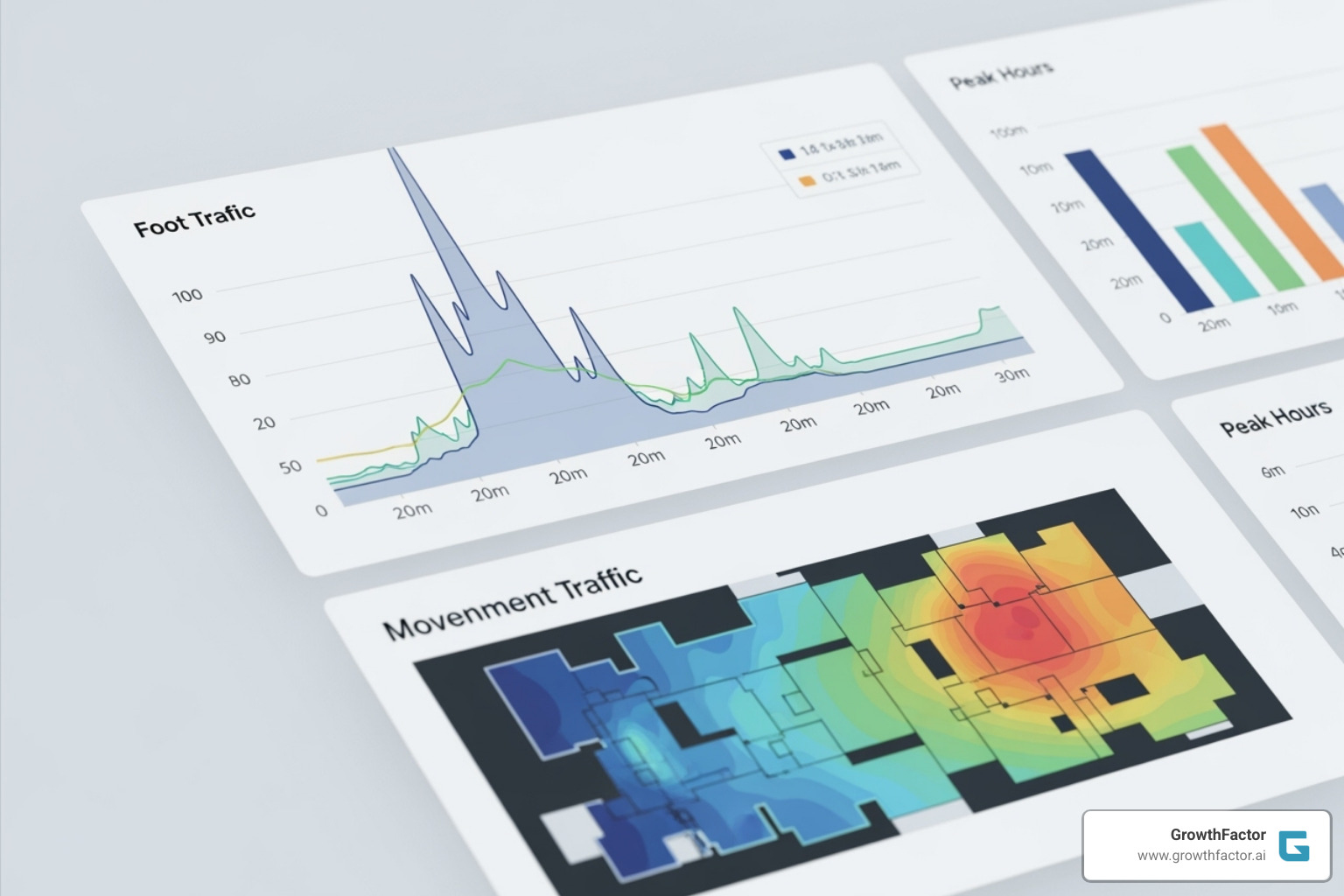
Modern foot traffic analysis goes beyond counting heads to reveal visitor demographics, journey origins, and even their next destinations. This data matters because it bridges the gap between digital analytics and real-world behavior. While online metrics show clicks, foot traffic data reveals actual human movement, confirming that physical locations remain vital to commerce strategy.
This intelligence drives operational efficiency by identifying peak hours, creates a competitive advantage by benchmarking performance, and enables data-driven decisions on everything from staffing to store layout. For a comprehensive understanding, explore our Footfall Traffic: The Complete Guide.
Understanding the Importance for Your Business
Foot traffic analysis answers critical retail questions. Where should we open our next store? When do we need more staff? Is our marketing driving visits? Strategic planning becomes precise when you can identify sites with proven traffic potential instead of relying on gut feelings. Marketing ROI becomes measurable in actual store visits, while staffing and merchandising are optimized based on real-world customer flow. Site selection becomes a data-backed investment rather than an expensive gamble. For deeper insights, check out our guide on Retail Foot Traffic Data.
Bridging the Online-Offline Divide
Today's customer journey is fluid, moving seamlessly between online research and in-store experiences. Foot traffic analysis is key to a unified commerce strategy, connecting digital engagement with physical visits to create a holistic customer view. Understanding how a customer's online browsing leads to an in-store visit reveals crucial insights into their decision-making process. Businesses using unified commerce platforms see tangible benefits, including a 22% better total cost of ownership, by enabling more accurate customer segmentation and personalized campaigns that resonate across all touchpoints. For more on this integration, read Foot Traffic Analysis — Customer Behaviour Analysis with Offline and Online Method.
How to Collect Accurate Foot Traffic Data
Effective foot traffic analysis begins with high-quality data collection. Modern technology offers numerous ways to gather this information, moving far beyond manual headcounts. The challenge is collecting data that is accurate, timely, and actionable.
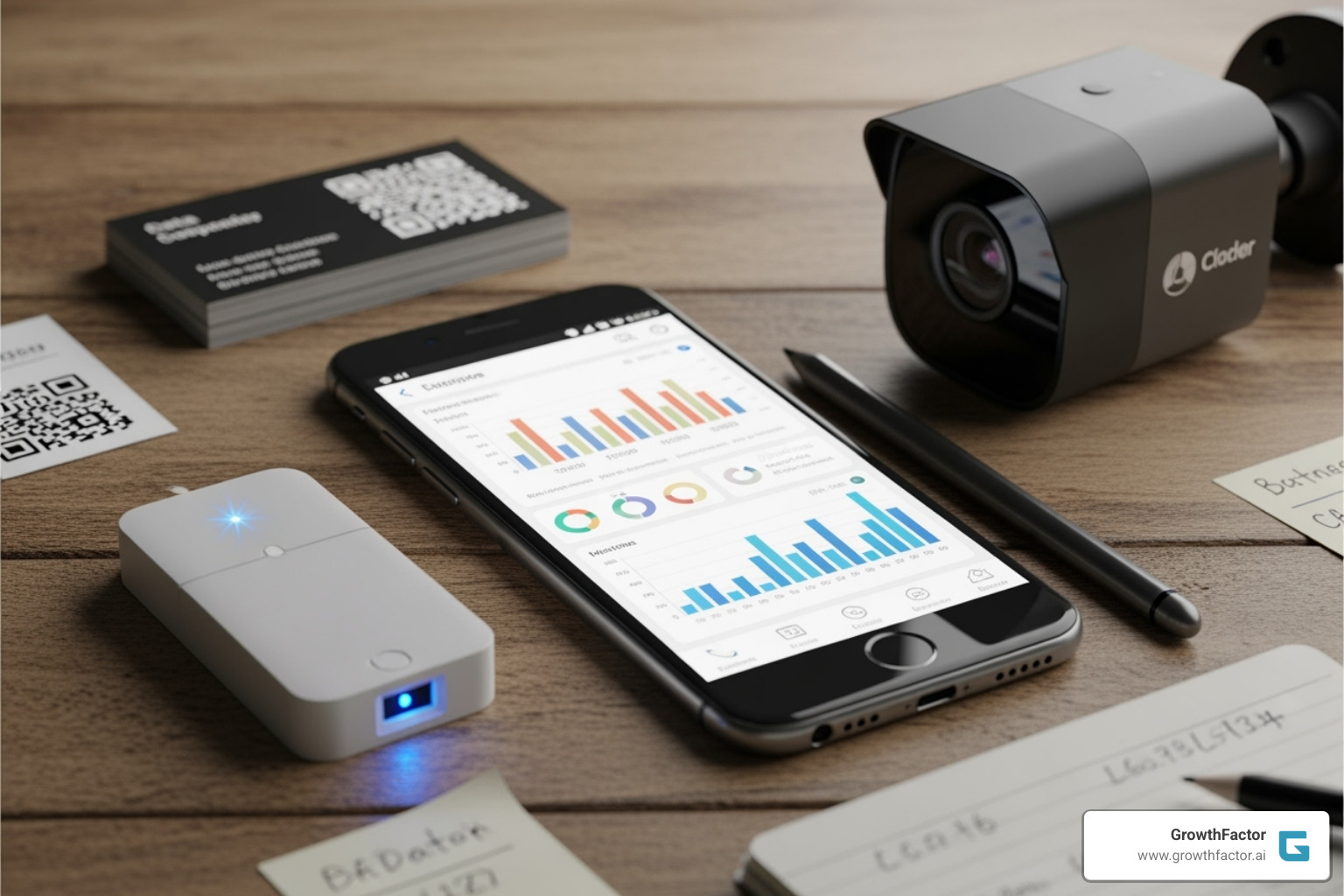
Modern Digital Collection Methods
The digital revolution has transformed foot traffic tracking. With hundreds of millions of smartphones in use, mobile device GPS data has become a primary source. Companies collect anonymized and aggregated location data through apps with user consent, creating detailed pictures of movement patterns.
- Wi-Fi tracking uses existing internet infrastructure to detect and count enabled devices, helping to understand dwell times and repeat visitors.
- Video analytics with AI turns security cameras into sophisticated people counters that can track paths and estimate visitor counts without identifying individuals.
- AI-powered data collection integrates data from multiple sources, using machine learning to filter out noise and identify meaningful behavioral patterns.
Hardware and In-Store Systems
Dedicated hardware provides granular, location-specific data from within your four walls.
- People counting sensors (e.g., thermal, infrared) are reliable tools placed at entrances to get precise entry and exit counts.
- Point-of-sale (POS) data integration is crucial. It connects traffic counts with sales data, allowing you to calculate conversion rates and understand the value of your foot traffic.
- Manual counting is outdated for ongoing analysis. It's inconsistent, labor-intensive, and lacks the rich behavioral data of automated methods.
Ensuring Data Quality and Privacy
Raw data requires processing to be useful. Quality foot traffic analysis depends on data validation and responsible privacy practices.
- Data validation uses algorithms to clean raw data, filtering out anomalies like GPS drift to ensure a data point represents a true visit. Properly validated data can achieve research-grade accuracy.
- POI data accuracy is vital. An accurate database of Points of Interest, including brand information and spatial hierarchies, ensures GPS pings are attributed to the correct physical locations.
- Privacy protection is non-negotiable. Reputable platforms use anonymized and aggregated data, meaning individual identities are removed. Compliance with regulations like GDPR and CCPA is mandatory, and ethical data use builds the trust necessary for this analysis to be effective.
How Do You Perform Foot Traffic Analysis?
Once you've gathered foot traffic data, the analysis phase turns raw numbers into strategic insights. This process is about asking your data the right questions to uncover stories about customer behavior, peak times, and hidden opportunities.
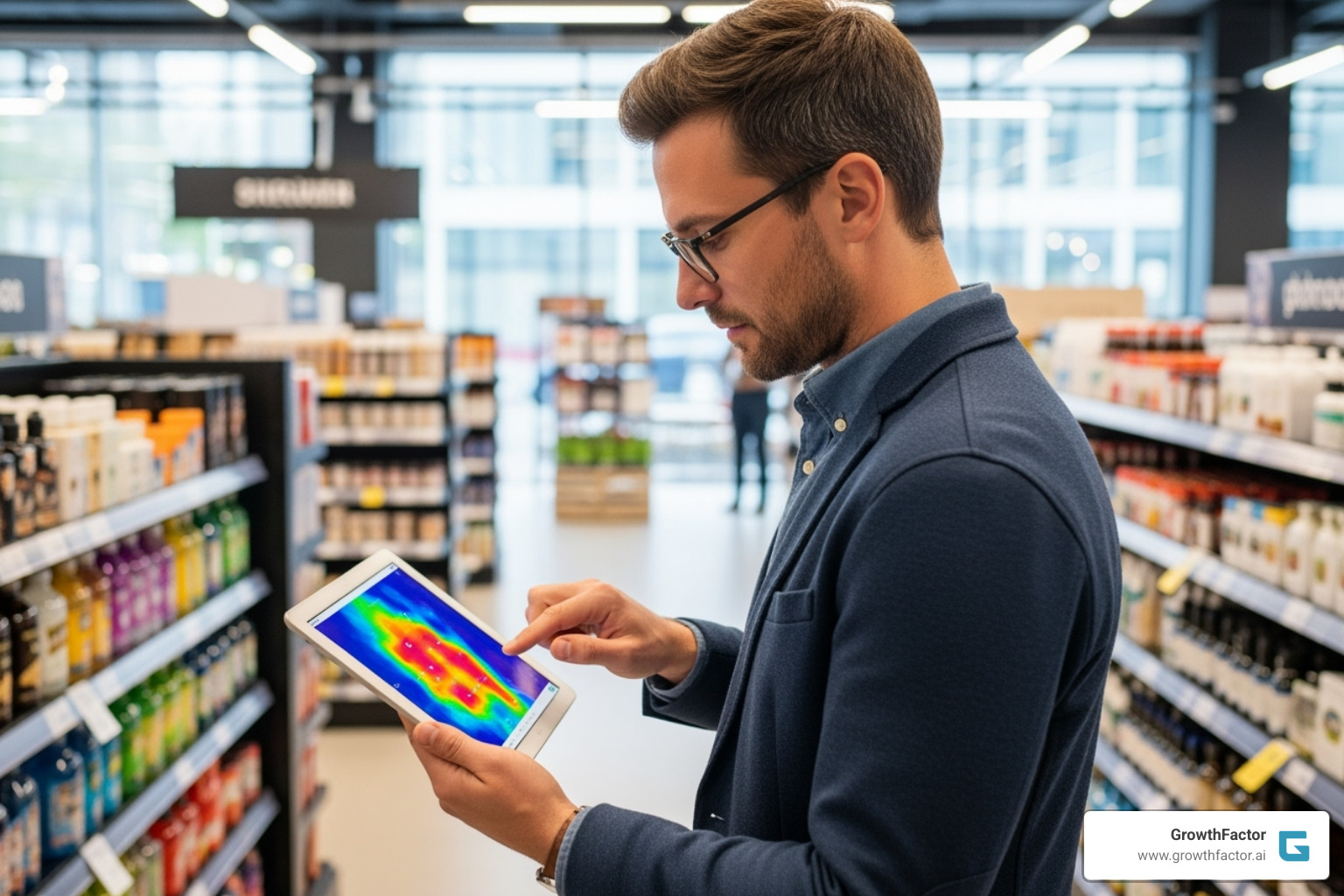
Foot traffic analysis is more than counting people; it's about understanding the why behind the numbers. Why did one day see a visitor spike? Why do customers linger in one area? This analysis is the foundation for everything from staffing to inventory. Our guide on Foot Traffic Analytics dives deeper into these applications.
What are the Key Metrics for Foot Traffic Analysis?
Successful analysis focuses on the KPIs that align with your business goals. These metrics work together to paint a complete picture of performance.
- Visitor Count: The total number of people entering your location. It measures popularity but not profitability.
- Dwell Time: How long visitors stay, indicating engagement.
- Conversion Rate: The percentage of visitors who make a purchase (transactions ÷ visitors). This metric connects traffic directly to revenue.
- Pass-by Traffic: The potential market of people who pass your location but don't enter.
- Visit Frequency: How often customers return, signaling loyalty.
- Customer Journey Mapping: Tracks movement inside your space to reveal popular zones and dead spots.
- Peak Hours and Days: Identifies your busiest times to optimize operations.
For more on connecting traffic to sales, Foot Traffic and Conversion Rate Analysis provides useful frameworks.
A Step-by-Step Guide to Analyzing Your Data
Effective analysis follows a systematic approach. First, establish consistent collection procedures to ensure your data is reliable and comparable over time.
Next, identify key trends by examining daily, weekly, and seasonal patterns to establish a baseline for performance. Creating heat maps visualizes where people spend time in your space, revealing which displays draw attention and where bottlenecks occur.
Predictive analytics takes this a step further, using historical data and external factors (like weather or local events) to forecast future traffic. This enables proactive staffing and inventory planning.
The real power emerges when you integrate demographic and psychographic datasets. This combination reveals not just how many people visit, but who they are and what motivates them. Modern AI-powered analytics platforms excel at processing these complex datasets to identify patterns and provide recommendations. Our AI-Powered Retail Analytics platform specializes in turning complex data into clear, actionable insights.
Strategic Applications: Turning Insights into Action
This is where foot traffic analysis delivers tangible business wins. It’s about using data to make smarter decisions that guide everything from real estate strategy to daily operations.
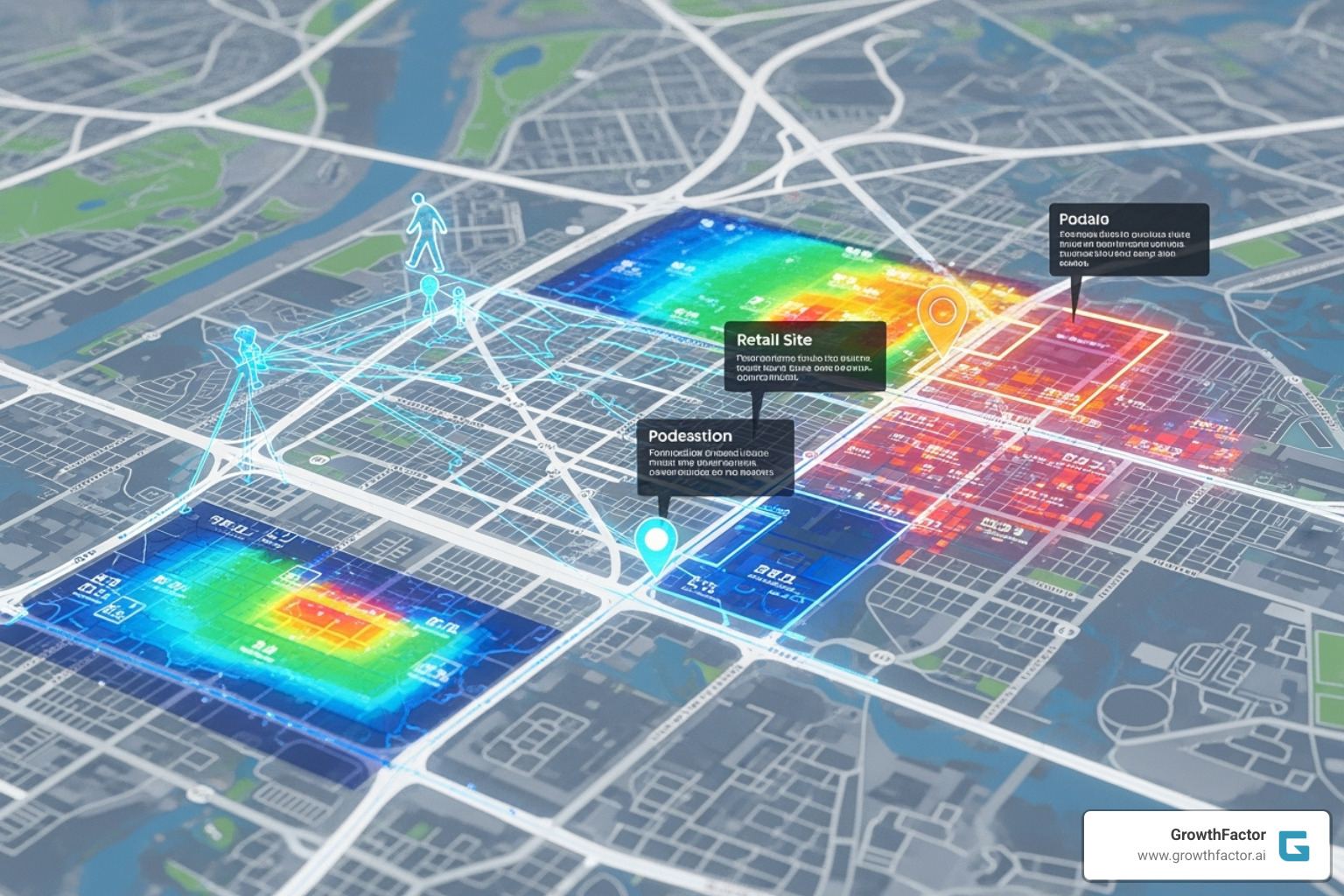
When we treat foot traffic data as a strategic compass, every data point becomes a tool for growth.
Data-Driven Site Selection and Market Planning
For choosing new locations, foot traffic analysis provides x-ray vision for retail real estate. Instead of relying on gut feelings, you can see how people move through potential areas.
- Identify high-potential locations by comparing actual visitor volumes and demographic match across sites. This helps focus on High Foot Traffic areas that are more likely to convert.
- Trade area analysis maps your true catchment area by tracking where visitors come from, which is essential for predicting a new location's performance.
- Cannibalization analysis shows whether a new store will attract new customers or simply steal them from an existing location, preventing costly mistakes.
- Rightsizing decisions—expanding, downsizing, or relocating—are supported by objective data, enabling comprehensive Data-Driven Site Selection strategies.
Competitive Intelligence and Benchmarking
Foot traffic analysis offers anonymous, accurate insights into competitor performance.
- Analyze competitor traffic to reveal their peak hours, busy days, and potential weaknesses you can exploit.
- Evaluate market share with precision by comparing visitor volumes across all players in a trade area.
- Cross-visitation patterns reveal customer behavior, such as which other stores your customers frequent, opening up partnership or co-marketing opportunities.
- Identify market gaps by finding areas with high foot traffic but few competitors in your category. Our Retail Location Analysis approach helps spot these opportunities.
Optimizing Operations and Marketing Campaigns
Day-to-day applications of foot traffic analysis often deliver the most immediate ROI.
- Evaluate marketing effectiveness by tracking traffic spikes during promotional periods to measure offline attribution with accuracy.
- Optimize store layouts using heat maps to understand customer flow. This allows you to improve product placement by moving high-margin items to high-traffic zones.
- Improve staff scheduling by aligning staffing levels with data-proven busy periods.
- Focus geotargeted advertising by reaching people who have visited your locations or trade areas, dramatically improving ad spend efficiency.
The Future of Foot Traffic Analysis
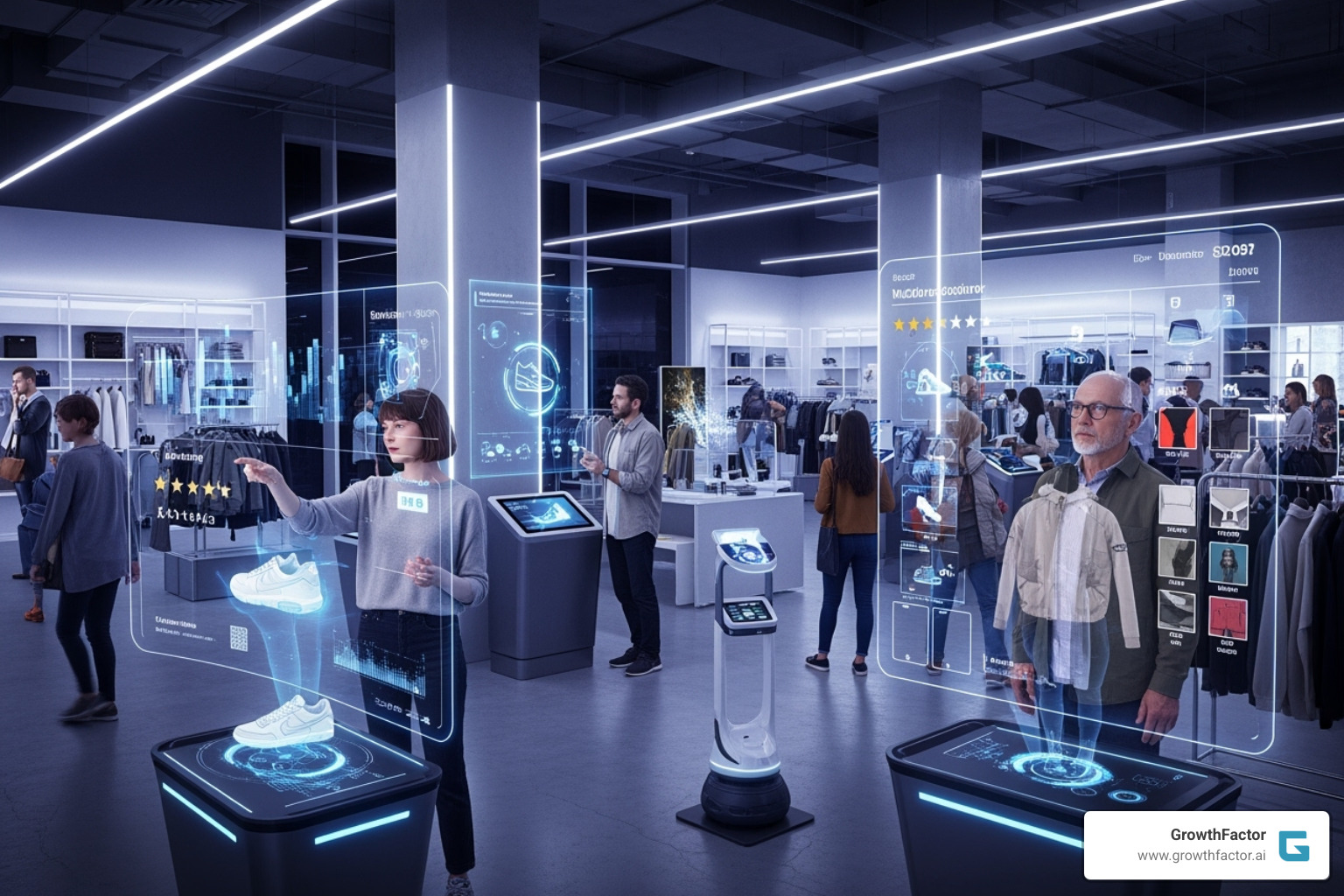
Foot traffic analysis is evolving rapidly. What began as simple door counters has become a sophisticated system for predicting customer behavior and optimizing retail experiences in real-time.
Artificial intelligence and machine learning are at the heart of this revolution. These technologies process vast datasets to identify patterns and predict traffic fluctuations, giving businesses advance notice of potential changes. This predictive power is a core component of modern AI Location Intelligence.
Real-time alerts are also becoming standard, notifying managers of sudden traffic surges or drops so they can respond immediately. The ultimate goal is unified online-offline analytics, seamlessly connecting a customer's digital journey with their physical store visits for a complete behavioral picture.
This evolution is critical, as the retail landscape faces immense pressure. With e-commerce adoption growing, one UBS forecast predicts up to 50,000 retail outlets may close by 2027. This stark reality, detailed in the UBS forecast on retail closures, makes advanced foot traffic analysis essential for survival.
The retailers who thrive will be those who use every tool to understand their customers and optimize their physical footprint. Foot traffic analysis provides the insights needed to make smart decisions about which locations to keep, where to expand, and how to create experiences that draw people into stores.
Frequently Asked Questions about Foot Traffic Analysis
What is the difference between foot traffic and store visitors?
These terms are often confused but have a critical distinction. Foot traffic (or pass-by traffic) includes everyone who passes your location. Store visitors are the subset of that traffic who actually enter your store.
Understanding this difference is key. It allows you to create a basic conversion funnel (passersby -> visitors -> customers). If you have high foot traffic but few visitors, your storefront may need improvement. If you have high visitor counts but low sales, the issue may be your in-store experience.
How can small businesses leverage foot traffic data effectively?
Foot traffic analysis isn't just for large chains. Small businesses can gain immense value by focusing on local-level insights.
- Identify local competitors and understand their traffic patterns to find opportunities.
- Optimize operating hours based on when your neighborhood is busiest, not just on tradition.
- Focus marketing on nearby areas with high concentrations of your target demographic.
- Use accessible tools like Google's Popular Times to get a free, high-level view of local activity patterns.
The key is to concentrate on your immediate trade area to make smarter, data-informed decisions without a massive budget.
What are the privacy considerations for foot traffic analysis?
Privacy is a valid concern. Reputable foot traffic analysis providers operate with strict safeguards to protect individuals.
- Anonymization and aggregation are foundational. Data is studied in large groups, with all personally identifiable information (PII) removed. The focus is on trends (e.g., "50 people visited between 2-3 PM"), not individuals.
- Compliance with regulations like GDPR and CCPA is mandatory. These laws enforce strict standards for data collection and use.
- Ethical data use is paramount. The goal is to improve business efficiency and customer experiences—such as optimizing store hours or layouts—not to intrude on personal privacy. When handled responsibly, this data helps businesses better serve their communities.
Conclusion: Walk Smarter, Not Harder
The retail landscape is changing at an accelerating pace. With forecasts predicting tens of thousands of store closures in the coming years, the stakes for physical businesses have never been higher. In this environment, data-driven decision-making is no longer optional.
Foot traffic analysis has become the essential tool that separates thriving retailers from struggling ones. It replaces guesswork with evidence, allowing businesses to understand customer flow with clarity.
Throughout this guide, we've seen how modern methods provide unprecedented visibility into customer behavior and how analysis turns that data into actionable insights. These insights drive real business value, whether you're selecting new sites, optimizing store layouts, or timing marketing campaigns.
The businesses that will succeed are those that understand their customers' physical journeys as clearly as their digital ones. They can predict traffic patterns, optimize operations, and identify growth opportunities before the competition.
At GrowthFactor, our AI-improved platform and dedicated analyst services are built to provide these strategic insights, turning foot traffic data into a competitive advantage. We help you understand what the numbers mean for your bottom line.
The future belongs to businesses that walk smarter. The tools are here, the data is rich, and the opportunity is now.
Ready to transform your site selection strategy with the power of foot traffic intelligence? Find how to master your site selection strategy and see how GrowthFactor can help you walk confidently into your next growth phase.
Citations
The human algorithm
Ready to see what we're cooking?
Submit your information below and we'll be in touch to schedule.



